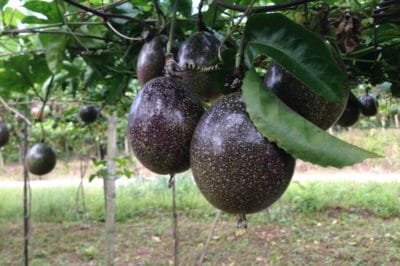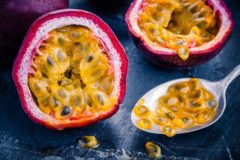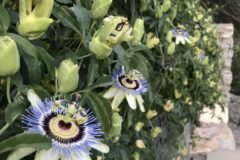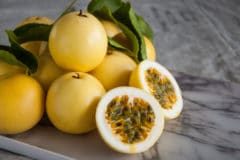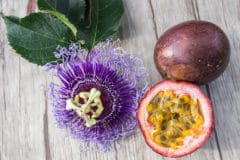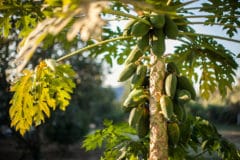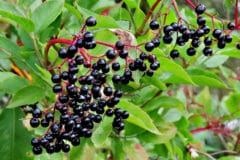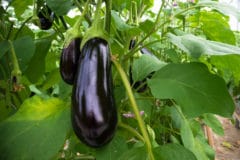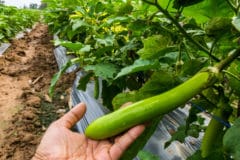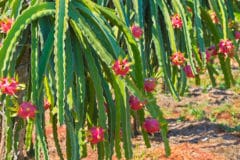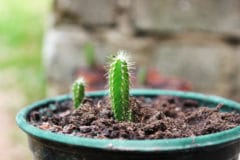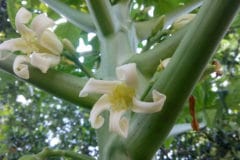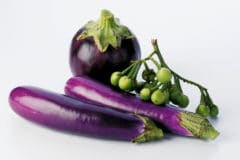Climates Where Passion Fruit Grows
Purple varieties (edulis) are native to the South American countries of northern Argentina, Brazil and Paraguay. Yellow passion fruit, an edulis subspecies grows in the Amazon.
The coastal regions of Queensland, Australia also grow purple passion fruit, as well as New Zealand. Seeds brought from Australia to Hawaii in the 1880s, made passion fruit popular for Hawaiian home landscaping. Other areas where passion fruit grows are:
- California
- Florida
- Columbia
- Dominican Republic
- East Africa
- India
- Indonesia
- Mexico
- Peru
- Philippines
- Puerto Rico
- South Africa
- Sri Lanka
Specific Climate Conditions for Growing Passion Fruit
Purple and yellow passion fruit plants need certain climate conditions to produce foliage and fruit. The following factors give passion fruit the best chances for a successful harvest.
- Purple fruit needs altitudes of 2,000 to 4,000 feet.
- Yellow fruit needs altitudes of 2,000 feet.
- U.S. Department of Agriculture hardiness zones 9 to 11
- Temperatures from 68° (20°) to 82° (27.7°)
- Protection from wind
- Yearly rainfall of 35 inches
- Full sun when near the coast
- Partial sun inland where it’s hot and dry
Soil Conditions in Areas Where Passionfruit Grows
Passion fruit prefers sandy soil that drains well and has rich organic matter. For the best growing conditions, the soil should have a pH of 6.5 to 7.0. Since the purple varieties are sensitive to soil diseases, they definitely require well-drained soil. Mulching and raised beds help with drainage, if your soil doesn’t meet the conditions.
About Purple Passion Fruit
The following cultivars include several purple passion fruit developed for growing in suitable climates, as well as indoor pots.
- Black Knight – These plants produce deep purple, fragrant fruit suitable for container growing. The fruit is about the size of an egg with an oval shape. They are self-fertilizing, compact plants with shiny foliage. Patrick Worley cultivated these for growing indoors in Massachusetts.
- Edgehill – Originally from Vista, California, these plants produce large fruit and grow quickly. The growing conditions in Southern California are ideal for this cultivar.
- Frederick – Patrick Worley also cultivated this plant in Lincoln Acres, California. It produces large, oval fruit that has a tart flavor. Many people use the fruit for juicing. It grows quickly and self-pollinates.
- Kahuna – This cultivar produces medium-sized fruit but the plant grows very large. The fruit has an acidic taste that’s popular for juicing. It also features large flowers and foliage.
- Paul Ecke – Originating in Encinitas, California, this cultivar grows medium, high-quality fruit. You can eat the fruit fresh from the vine or use it for juicing. This is a compact plant.
- Purple Giant – This cultivar grows very large, deep purple fruit.
- Red Rover – Patrick Worley cultivated this plant in Lincoln Acres, California. It grows medium, round fruit that has a red rind. It is sweeter than most passion fruit, which makes it good for both eating fresh or for juicing. It is a compact plant.
About Yellow Passion Fruit
Yellow passion fruit doesn’t have as many cultivars as the purple varieties. Two of the yellow cultivars that grow in sub-tropical to tropical climates are the Brazilian Golden plant, which requires cross-pollination and grows very quickly. Carpenter bees are the most effective pollinators of this plant. The Brazilian Golden, produces large, white flowers with a dark middle. You can see these fragrant blossoms in mid-summer. The flowers produce large, yellow fruit in late August into the beginning of September. Another cultivar is the Golden Giant. this plant is originally from Australia and produces large, golden fruit.
